Project Scope Management includes the processes required to ensure that the project includes all the work required, and only the work required, to complete the project successfully.
Plan Scope Management - The process of creating a scope management plan that documents how the project scope will be defined, validated, and controlled.
Collect Requirements - The process of determining, documenting, and managing stakeholder needs and requirements to meet project objectives.
Define Scope - The process of developing a detailed description of the project and product.
Create WBS - The process of subdividing project deliverables and project work into smaller, more manageable components.
Validate Scope - The process of formalizing acceptance of the completed project deliverables.
Control Scope - The process of monitoring the status of the project and product scope and managing changes to the scope baseline.
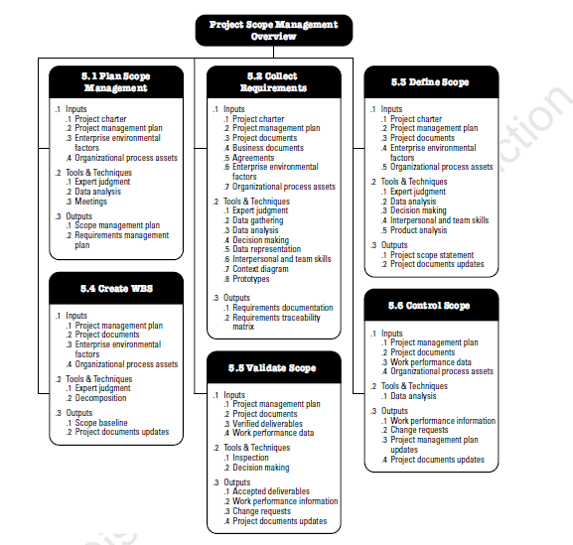
Key Concepts:
Product scope. The features and functions that characterize a product, service, or result; and/or Project scope. The work performed to deliver a product, service, or result with the specified features and functions. The term project scope is sometimes viewed as including product scope.
Completion of the project scope is measured against the project management plan
Completion of the product scope is measured against the product requirements
Scope Management depends on the approach taken for Project Management – Predictive or Agile.
In Predictive approach the scope is defined and agreed upon at the beginning
In Agile approach, the collect requirements, define scope and create WBS processes are done iteratively to take care of changing scope and all the stakeholders are engaged in defining scope and validating deliverables iteratively.
Trends and Emerging Practices
Collaborating with Business analysis professionals to
- Determine probems and identify business needs
- Identify and recommend viable solutions for meeting those needs
- Elicit, document, and manage stakeholder requirements in order to meet business and project objectives
- Facilitate the successful implementation of the product, service or end result of the program or the project
Tailoring Considerations:
- Knowledge and requirement management
- Validation and control
- Development approach
- Stability of requirements
- Governance
Considerations for Agile / Adaptive Environments
In Agile / Adaptive environment, the scope is not understood at the beginning of the project and it evolves during the project.
Agile methodology spend less time to define and agree the scope in the early stages of the project and spend more time establishing the process for its ongoing discovery and refinement.
Agile build and review prototypes and release versions in order to refine the requirements.
In Agile approaches, the requirements constitute the backlog
Plan Scope Management:
Plan Scope Management is the process of creating a scope management plan that documents how the project scope will be defined, validated, and controlled.
The key benefit of this process is that it provides guidance and direction on how scope will be managed throughout the project.
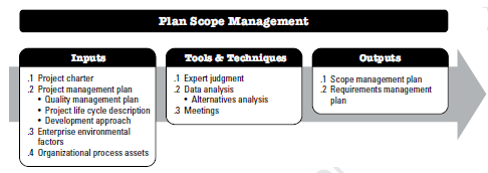
Plan Scope Management - Output:
The components of the Scope Management Plan can include:
- Process for preparing a detailed project scope statement;
- Process that enables the creation of the WBS from the detailed project scope statement;
- Process that establishes how the WBS will be maintained and approved;
- Process that specifies how formal acceptance of the completed project deliverables will be obtained; and
- Process to control how requests for changes to the detailed project scope statement will be processed.
The componenets of the Requirement Management Plan can include
- How requirements activities will be planned, tracked, and reported;
- Configuration management activities such as: how changes to the product will be initiated, how impacts will be analyzed, how they will be traced, tracked, and reported, as well as the authorization levels required to approve these changes;
- Requirements prioritization process;
- Product metrics that will be used and the rationale for using them; and
- Traceability structure to reflect which requirement attributes will be captured on the traceability matrix.
Collect Requirements:
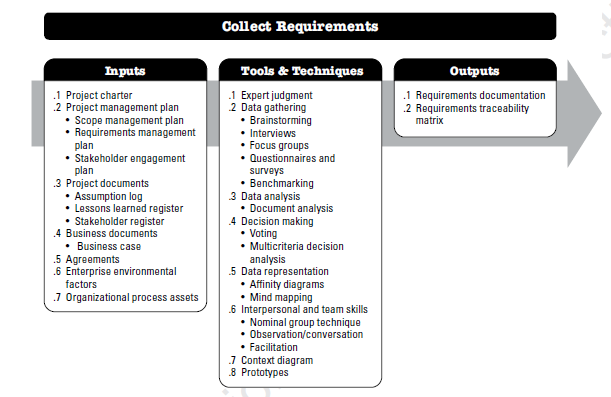
Collect Requirements is the process of determining, documenting, and managing stakeholder needs and requirements to meet project objectives.
The key benefit of this process is that it provides the basis for defining and managing the project scope including product scope.
Collect Requirement - Tools:
Data Gathering
- Brainstorming - A technique used to generate and collect multiple ideas related to project and product requirements.
- Interviews - An interview is a formal or informal approach to elicit information from stakeholders by talking to them directly.
- Focus Groups - Focus groups bring together prequalified stakeholders and subject matter experts to discuss on requirements in presence of a moderator.
- Questionnaires and Surveys - Questionnaires and surveys are written sets of questions designed to quickly accumulate information from a large number of respondents.
- Benchmarking - Benchmarking involves comparing actual or planned practices, such as processes and operations, to those of comparable organizations to identify best practices and generate ideas for improvement
Decision Making
- Voting - Voting is an assessment process having multiple alternatives with an expected outcome in the form of future actions.
- Unanimity - A decision that is reached whereby everyone agrees on a single course of action. One way to reach unanimity is the Delphi technique, in which a selected group of experts answers questionnaires and provides feedback.
- Majority - A decision that is reached with support obtained from more than 50 % of the members of the group.
- Plurality - A decision that is reached whereby the largest block in a group decides, even if a majority is not achieved.
- Dictatorship - In this method, one individual makes the decision for the group.
Multi criteria decision analysis
A technique that utilizes a decision matrix to provide a systematic analytical approach for establishing criteria, such as risk levels, uncertainty, and valuation, to evaluate and rank many ideas.
Data Analysis
Document Analysis - Document analysis is used to elicit requirements by analyzing existing documentation and identifying information relevant to the requirements.
Data Representation:
Idea/mind mapping - A technique in which ideas created through individual brainstorming sessions are consolidated into a single map to reflect commonality and differences in understanding, and generate new ideas.
Affinity diagram - A technique that allows large numbers of ideas to be classified into groups for analysis
Interpersonal and Team skills
- Nominal group technique - A technique that enhances brainstorming with a voting process used to rank the most useful ideas for further brainstorming or for prioritization.
- Facilitated Workshops - Facilitated workshops are focused sessions that bring key stakeholders together to define product requirements are below points (1 & 2).
- Joint application design/development (JAD) sessions are facilitated sessions focus on bringing business subject matter experts and the development team together to improve the software development process.
- Quality function deployment (QFD) is example of a facilitated workshop technique that helps determine critical characteristics for new product development. QFD starts by collecting customer needs, also known as voice of the customer (VOC).
- Observations - Observations provide a direct way of viewing individuals in their environment and how they perform their jobs or tasks.
Context Diagrams
Context diagrams visually depict the product scope by showing a business system (process, equipment, computer system, etc.), and how people and other systems (actors) interact with it.
Context diagrams show inputs to the business system, the actor(s) providing the input, the outputs from the business system, and the actor(s) receiving the output.
Prototypes
Prototyping is a method of obtaining early feedback on requirements by providing a working model of the expected product before actually building it.
Collect Requirements - Outputs
- Requirements Documentation which includes all the project requirements in sufficient detail and describes how they meet the business need for the project. It is useful to indicate a priority for requirements and to also group them by category (e.g., business, stakeholder, project, quality, legal, etc.)
- Requirements Traceability Matrix which is a table that links requirements from their origin to their corresponding deliverables. It also includes the link to the business and project objectives to ensure that each requirement is adding business value. The Requirements Traceability Matrix is used to trace requirements throughout the project life cycle.
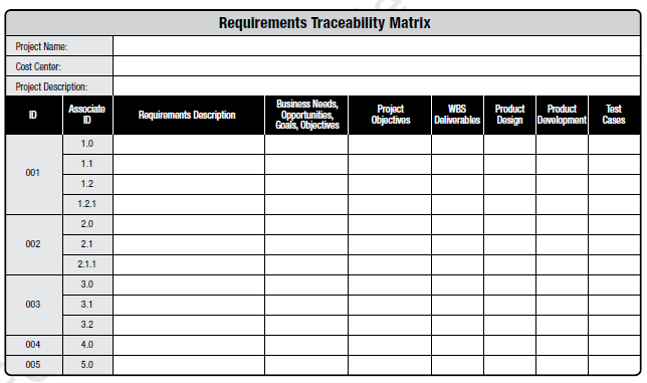
- Business requirements, which describe the higher-level needs of the organization as a whole
- Stakeholder requirements, which describe needs of a stakeholders.
- Solution requirements, which describe features, functions, and characteristics of the product, service, or result that will meet the business and stakeholder requirements.
1. Functional requirements describe the behaviors of the product.
2. Nonfunctional requirements supplement functional requirements and describe the environmental conditions
or qualities required for the product to be effective
- Transition requirements describe temporary capabilities, such as data conversion and training requirements, needed to transition from the current “as-is” state to the future “to-be” state.
- Project requirements, which describe the actions, processes, or other conditions the project needs to meet.
- Quality requirements, which capture any condition or criteria needed to validate the successful completion of a project deliverable or fulfillment of other project requirements
Define Scope
Define Scope is the process of developing a detailed description of the project and product.
The key benefit of this process is that it describes the project, service, or result boundaries by defining which of the requirements collected will be included in and excluded from the project scope.
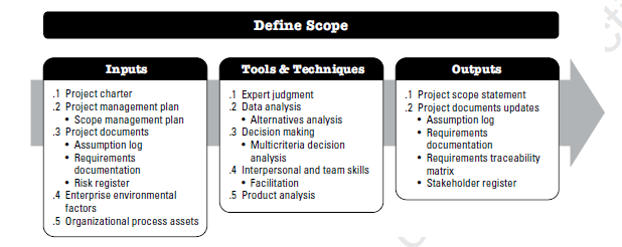
Define Scope - Tools
Product Analysis
- For projects that have a product as a deliverable, as opposed to a service or result, product analysis can be an effective tool.
- Each application area has one or more generally accepted methods for translating high-level product descriptions into tangible deliverables.
- Product analysis includes techniques such as product breakdown, systems analysis, requirements analysis, systems engineering, value engineering, and value analysis.
Alternatives Analysis
Alternatives Analysis is a technique used to develop as many potential options as possible in order to identify different approaches to execute and perform the work of the project. A variety of general management techniques can be used, such as brainstorming, lateral thinking, analysis of alternatives, etc.
Define Scope - Output
The Project Scope Statement provides a documented basis for future project decisions regarding the project and product scope. It includes the following key components:
- Product Scope Description - includes detailed elaboration of product characteristics
- Acceptance Criteria - are required conditions for deliverable acceptance
- Assumptions - are factors that are considered to be true without certainty
- Constraints - are limits or restrictions on project parameters (e.g., predefined budget or schedule, contract obligations)
- Exclusions - state what is out of scope so stakeholder expectations can be managed
- Deliverables - which are the unique product, service, results of the project
Define Scope - Output
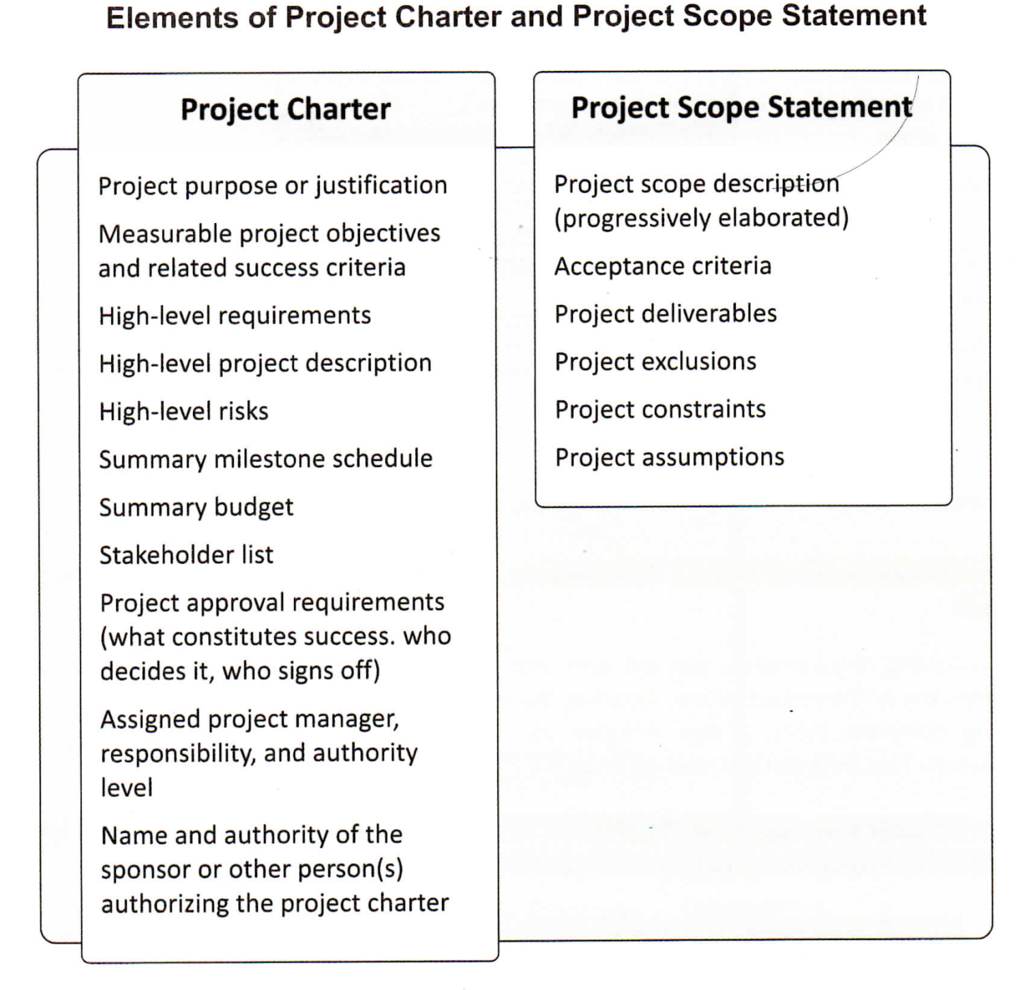
Create WBS
Create WBS is the process of subdividing project deliverables and project work into smaller, more manageable components.
The key benefit of this process is that it provides a structured vision of what has to be delivered.
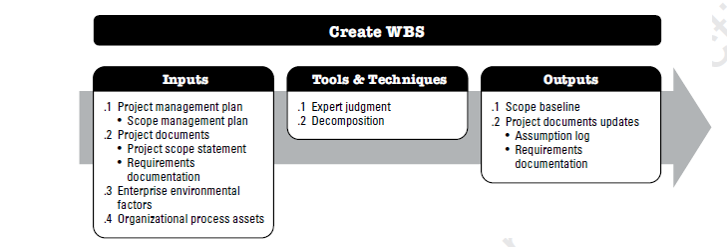
The WBS:
- Is a deliverable-oriented, hierarchical decomposition of the work to be executed by the project team.
- Is developed by the project team. Since the whole team is involved, this provides team 'buy-in' or 'shared ownership', and provides for better communication between the project team and stakeholders.
- Contains all the work defined in the project scope. Work not in the WBS is considered out of scope.
- Decomposition of the scope of work is extended until it is acceptable to stakeholders for planning, delivery, and control.
- Excessive decomposition can lead to non-productive project management effort, inefficient use of resources, and decreased efficiency in performing the work.







